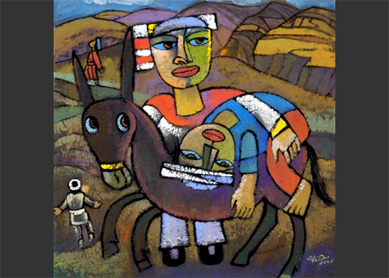Where and when did Purim originate?
Purim is the first explicitly human-made festival in the Bible. While the pilgrimage festivals of Passover, Sukkot, and Shavuot have their roots in agricultural practices and historical commemorations of the Iron Age, the festival of Purim was first celebrated by the Jews centuries later, in the times of the Second Temple. While the pilgrimage festivals, as well as Rosh Hashanah and Yom Kippur, are commanded by God in the Torah, Purim is said to be the invention of the Jews and their leaders under the Persian Empire.
The origins of Purim are described in the biblical book of Esther. The annual celebration on the 14th of Adar (the last month in the Jewish year) is said to commemorate the salvation of the Jews from the genocidal plot of the royal advisor Haman.
Although the book of Esther and the festival of Purim probably have their origins in the eastern diaspora (Mesopotamia and Persia), the earliest explicit mention of Purim is in the book of 2 Maccabees from late second-century BCE Alexandria. The great victory of Judah the Maccabee over the Seleucid general Nicanor was celebrated annually on the anniversary of the battle, the 13th of Adar, and the book comments that this is the day before “Mordecai’s day.”
How is Purim celebrated?
The primary practices of Purim are “to make them into days of banquets and rejoicing, of sending presents to each other and gifts to the poor” (
Beyond the mandated rituals, Purim has long been celebrated in a carnivalesque mode, “a world turned upside down.” Children and adults dress in costumes, often breaking all barriers and taboos in doing so; cross-dressing is documented for many centuries. In premodern society, when people normally had to dress within certain expected norms, this day provided a release from all such obligations. The consumption of alcohol, already a major theme of the book of Esther itself, was also the norm on Purim, and the Talmud legislates that one must drink so that they “do not know the difference between ‘cursed is Haman’ and ‘blessed is Mordecai’” (b. Meg. 7b). In many communities, a fool was sent to pretend to be the rabbi, and Jews produced faux-rabbinic literature, which was often bitterly satirical. The practice of burning Haman in effigy is also long known, and on very rare occurrences, this fantasy of violence turned into real violence.
How was the holiday established?
The Talmud tells that Esther wanted her book to be accepted into the Bible, so she wrote to the rabbis in Jerusalem, “Establish me for generations!” The rabbis resisted, however, as they could find no license in the Bible for such a book. The book of Esther is indeed strange: most importantly, God is never mentioned! In the Talmudic story, license is eventually found, linking the book of Esther to the earlier clash with Amalek (
Aspects of this story are obviously fictional, but it does reflect a real ambivalence about Purim within the Jewish calendar. The focus on materiality and the reversal of norms so prevalent on this day sits at odds with the general Jewish calendrical focus on order and ritual. For that very reason, though, Purim has long been one of the most beloved holiday on the Jewish calendar.





